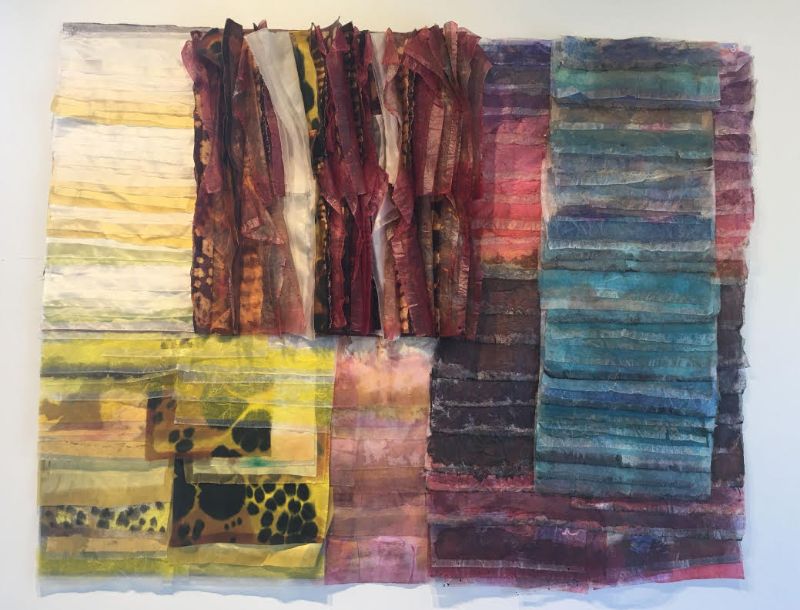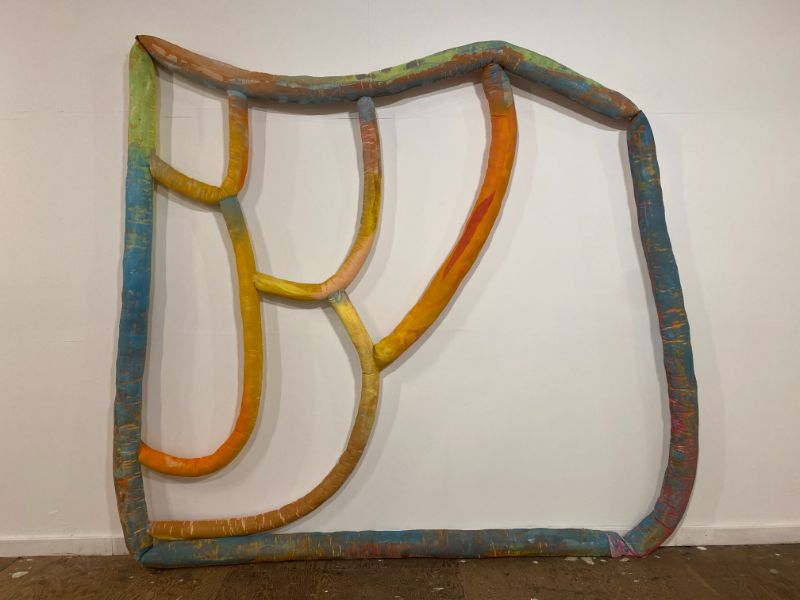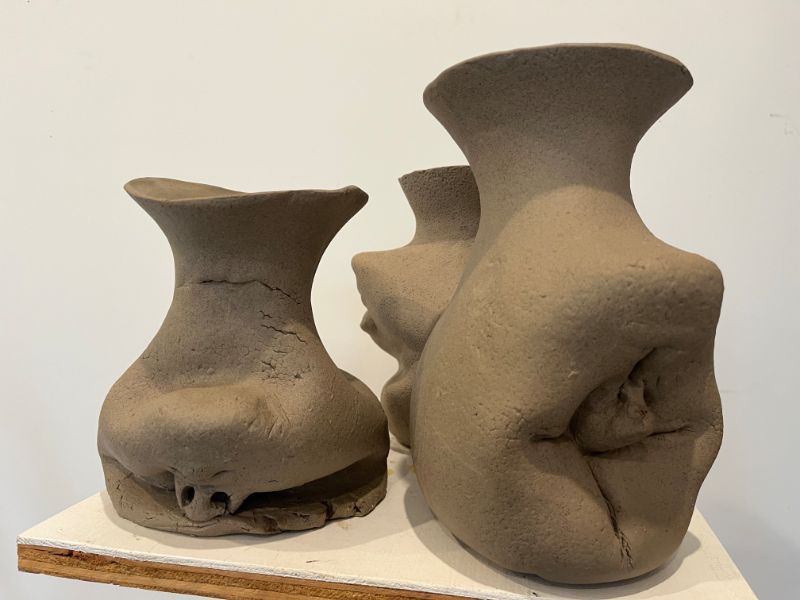Julia Kunin, Barbara Zucker
Meg Lipke, Catherine Hall, Joanne Howard
May 4th to June 15th
Opening Saturday May 4th 4pm to 6pm
The Re Institute is pleased to present the work of five artists connected by friendship: Julia Kunin, Barbara Zucker, Meg Lipke, Catherine Hall and Joanne Howard. Art making is often a lonely occupation. Some of the most consistent support comes from the close community around the artist. This is a show loosely based on this assumption. Julia and Joanne were both students at the Skowhegan school of art in 1984. Barbara was an artist in residence that summer who now lives in Burlington Vermont and is a friend of Catherine. Meg is Catherine’s daughter. Meg and Julia are art friends. This is the first exhibit of the 2024 season that is dedicated to the exploration of the power of prolonged friendships.
Barbara Zucker:
Barbara Zucker: Vase and Idea, 63 1/2” x 18 3/4” x 8 1/2”, 1985-1991, Cast aluminum
I’ve been making whatever “art” is since I was about five or six years old. Meaning, I took it seriously. My first memory of having made something rewarding and to me, important, was a large color drawing of the ice skater Sonia Heine, the star of The Ice Capades. The Ice Capades came to Philadelphia every year, and I went every year of my early childhood. The drawing had many figures and Heine was at the center of the page, larger than anyone else, wearing a blue, short-skirted outfit. My mother threw the drawing away. But I’m still at it.
Catherine Hall:

Catherine Hall: Untitled, 2015, Gauze paper, beeswax, fabric dye on paper,
36” x 42” x 3”
Meg Lipke is my daughter. She grew up watching me making art, albeit unconventional art - in the attic, in the bedroom, wherever I could find space until the point when I could afford a studio. I didn’t push Meg to be an artist, but I could see her determination and her work grow stronger and stronger. She has the self-confidence to take big risks in life and career and if I have contributed in any way to her development as an artist, that makes me proud.
When Barbara Zucker came to teach at the University of Vermont, Vermont artists such as myself benefited almost as much as her students. She organized lecture series, performance, art, collaborative exhibits, and studio visits that opened up new possibilities for me in my own work. Her support has been invaluable to me in hard times and in good times, and I am forever grateful for her friendship.
As a teenager in England, I had vacation jobs working in a textile mill that dyed and spun fancy yarns. I was accepted into art school at age 16 and later embarked upon a degree in art history at the University of Manchester. There, my professor warned me that I might as well abandon my wish to be a visual artist because I would never be able to come close to the achievements of the artists of the past. I came to the US for graduate study, married, had children and started a career teaching art history, and eventually started making art again. Not in the tradition of the Old Masters, not using paint on canvas, but choosing materials more associated with the textiles of my background, those involving dyes, fabric, wax, and paper. Working in the small fragments of time available to me, I dyed and accumulated stacks of gauze, like Japanese papers and silks, and attached them in flowing sequences onto a fabric or paper backing.
Meg Lipke:

Meg Lipke: Chamber, 2024, acrylic fabric dye on muslin, 111” x 124” x 6”
In different ways I have “grown-up” inside the art practices of three of the artists in this show. My mother is Catherine Hall, and her influence on my work can’t be overstated. Barbara Zucker moved into our hometown with her daughter when I was ten, and was soon “my best friend’s mom” and later a revered teaching artist who I wanted to impress. Julia is the older sister of a high school classmate and the first artist of my generation from our town to have a career as an artist. So in different ways I have watched these artists closely, modeling myself and my practice through their influence. I have known and paid attention to developments in their work and have seen them shift and take different risks, get attention for their work, and continue in times between shows. I feel a lineage here that sustains my own practice.
The piece I created specifically for this show, “Chamber”, is made with acrylic and fabric dye on muslin and is filled with polyester fiber to give it body. An outside frame holds a series of curving lines, attached to each other and affecting the movement each makes. The piece is about kinship.
I also thought about my mother's green and orange paper pieces, and how foundational that work has been for me. I've tried to echo that color palette in this piece.
I grew up in Vermont and knew I wanted to be an artist when I was a teenager. I went to UVM and then Cornell for an MFA in painting. My ideas about painting have shifted over the last 10 years and I now make work that takes the ingredients of painting and shifts them into a more dimensional place. I also still make paintings on stretchers.
Joanne Howard:

Joanne Howard: Making Faces, 8” x 12” x 12”, 2016 to 2023
The foundation of my artistic practice is rooted in my fascination with the human attraction to order and perfection. This attraction is bound to the concept of beauty and its inextricable ties to the natural world. My aim is to find the juncture between beauty, the decorative, and the concept of appearances. Through a visual language and in a variety of media, I am examining this tension while recognizing its bond to humor and the absurd.
I remember meeting Julia and Barbara at Skowhegan in the summer of 1984. At the time, it felt like the sculptors were one team, and the painters another–not in a competitive way, just separate. I was a painter, Julia a sculptor; even so, we became friends. (She taught me that the secret to long distance swimming was to move at the pace of your breathing.) Barbara and I did not connect until late into the residency when she was making her studio visit rounds. I had admired her from afar as an artist and educator and was therefore honored when she wanted to borrow one of my paintings to hang in her cottage for the rest of the summer. I don’t think my work from forty years ago had much overlap with either Barbara or Julia’s, but now, conceptually and in terms of materials, I see common ground and I’m thrilled to be showing with both of them.
Julia Kunin:
Julia Kunin: CERAMICS Zippering Figure, 48” x 20.5” x 3”, Ceramic, 2017
My work addresses sexuality, beauty, growth and decay. In creating queer sculptures that reference the figure, I combine an interest in symbols, coding and surrealism. My work has long been influenced by the decorative arts, with an emphasis on the study of Art Nouveau ceramics, which can be seen in the glazes and imagery that I use. Here the glitter and iridescence of the femme fatale has been transformed into a gender-fluid warrior. The interior mirroring in the work creates a baroque and performative visual onslaught. The abstracted portraits merge body, machine, and architecture. The totemic wall pieces verge on the grotesque, robotic and otherworldly, addressing sexuality while incorporating imagery from once utopian space age structures. The psychedelia of iridescence emphasizes the dream-like science fiction quality of the work.
I am inspired by being part of a community of artists, and by the expert craftspeople who often remain invisible, but create many of the everyday objects we encounter daily. I live in Brooklyn, New York where I have had a studio since 1987. Since 2010 I have spent summers in Pecs, Hungary, where I work at the University and local ceramics factories and an enamel factory, conducting research and developing new work. Learning from expert plaster carvers, mold-makers, china painters, architectural ceramic experts and enamel workers is critical to my work. In addition, learning languages is one of my passions that I have been able to combine with art making. Studying Hungarian has been an exciting challenge and a necessity, as well as a means to connect internationally. I have also been able to research Hungarian art that was state sanctioned or made underground at great risk. Hungarian artwork made during the Art Nouveau period as well as work created during the socialist era continues to have a great influence upon the generation of ideas for my sculptures.
I am deeply connected to the artists and curator of our show, through my hometown of Burlington, Vermont, and through Skowhegan. I couldn’t ask for a better aligning of the stars. Burlington, Vermont was an extraordinary place to grow up. After wandering around the campus when I was 13, I discovered the pottery shop in Williams Hall at the University of Vermont. Hideo Okino, then head of the shop in the 1970’s, invited me to work there for free, where I learned by watching the potters who he welcomed. In 1982, Barbara Zucker, then chair of the art department, welcomed me to work in the shop once again. I didn’t get to know her though until Skowhegan in 1984, where she was an artist in residence and mentor. I recall Barbara telling me never to compromise with my artwork, never do anything halfway. If you are going to make art, then make it exactly the way you want it. There are no excuses. Barbara’s words have stayed with me like a mantra. Joanne Howard welcomed me to New York right after Skowhegan, and I remember visiting her Mott Street apartment and being in awe. She said, you belong here, in New York. Her work at Skowhegan was magical, and I can visualize her rich, small, otherworldly paintings. I admire and feel very connected to Meg’s ambitious feminist work which is powerful and joyful, carrying on the tradition of fiber arts used by her mother and grandmother. Meg and I share our childhood city of Burlington and overlapping friendships. In so many ways, it is Barbara who keeps us all connected, and who is my beacon of taking risks and maintaining the highest standards. I feel very lucky to be showing with such great friends. Thank you Henry (Skowhegan ’84) for bringing us all together, in your extraordinary, welcoming space.